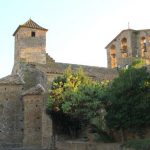The Croft Houses of Scotland
Above: Ruins of several Croft Houses in Scotland.
“The bonds of milk, nature, and culture are stronger than the bonds of blood.” Gaelic Proverb
A croft is a small agricultural unit, and the person who lives on this land is called a crofter. Crofts are usually rented, akin to sharecropping, and are located in one of the crofting areas designated by the government in Scotland. Crofters live on and work the land. They are tenants of the person who owns the land (the croft), but some of the tenants have now bought their crofts and become owner-occupiers. Traditionally, croft land is used to raise animals and grow vegetables. Now, some use the land for other means, such as tourism, forestry, or renewable energy.
Croft House History
Traditionally, crofts are situated on large estates, and are rented from the landowner. Landlords can have many crofts on their estate, and there are over 17,000 crofts in Scotland. But, the quest for a fair pattern of landownership has not been easy. 432 private owners control half the land in Scotland, a quarter of the country is still sporting estate. Much of the Highlands remain in the hands of the 50 largest estates.
Over the last forty years historians and historical geographers of the modern Highlands and Islands have accepted and developed James Hunter’s argument that in the second half of the nineteenth century a ‘crofting class’ emerged in the area which, based on an underlying feeling of being in ‘community’ as crofters, understood its identity in class-based terms. And yet, crofters are not recognized as indigenous by the Scottish or British parliaments, although they have long been campaigning for official recognition. This official status would make crofters the only indigenous group in Britain, and would give them greater protection from discrimination.
Crofters Advocate for Indigenous People Designation
J Martinez Cobo conducted a groundbreaking study in the 1980s into discrimination against indigenous groups for the United Nations. He wrote, “Indigenous communities, peoples, and nations are those which, having a historical continuity with pre-invasion and pre-colonial societies that developed on their territories, consider themselves distinct from other sectors of the societies now prevailing in those territories. They form at present non-dominant sectors of society and are determined to preserve, develop, and transmit to future generations: their ancestral territories, ethnic identity, cultural patterns, social institutions, legal systems, and language.” This historical continuity, Cobo said, may consist of occupation of ancestral lands.
The Scottish Crofting Foundation calls on the Scottish government to: recognize crofters as indigenous people of the Highlands and Islands; respect the growing body of international law on indigenous peoples; and devolve power and decision-making on indigenous issues to the people who maintain the indigenous cultures of the Highlands and Islands.
Since 1976 it has been legally possible for a crofter to acquire title to his croft, thus becoming an owner-occupier. The Land Reform (Scotland) Act 2003 gives crofters the right to buy their land.
Chambers Architects Restores Two Stone Ranches Built by European Masons
These Croft Houses are very similar in design to two historic Texas stone houses, originally built by European stone masons. They are currently under restoration by Chambers Architects and can be seen in these links:
https://chambersarchitects.com/custom-ranch-home-design/historic-west-texas-ranch/
https://chambersarchitects.com/historic-home-preservation/bosque-county-historic-ranch-restoration/
Characteristics of Croft Houses
Gable ends with fireplaces
Inset wooden pantries
Pigeon roosting cubbies
One front-entry door and a couple of windows on the warmer, less windy side of the house
Hand-painted wallpaper-underneath is either vertical or horizontal (shiplap-style) wood siding
Ceiling done in same manner with rafters
Occasional skylights
2-ft. thick stone walls
First floor: “dwelling area” with huge fireplace; next door kitchen with smaller fireplace
Second floor: two sleeping rooms over the lower rooms
Cut stone steps at entry
Crofts are often surrounded by hand-thrown stone walls
Many of the cabins are open and free to adventurous tourists and might have a wooden or iron bed. The properties are called Bothies.
A walking guide to Scottish Bothies can be found on Amazon: https://www.amazon.com/Scottish-Bothy-Bible-Geoff-Allan/dp/191063610X/ref=sr_1_1?crid=8SRAUMKN9PQO&dchild=1&keywords=the+bothy+bible&qid=1629899813&sprefix=The+Bothy+%2Caps%2C168&sr=8-1
VIDEO OF CROFTING-A 21ST CENTURY IDEA THAT STILL HAS MERIT: https://www.youtube.com/watch?v=-83Aimdmsmg





